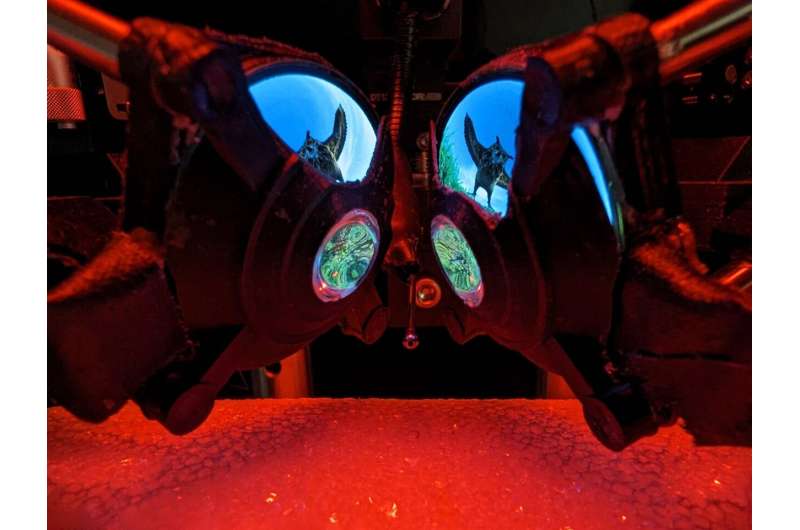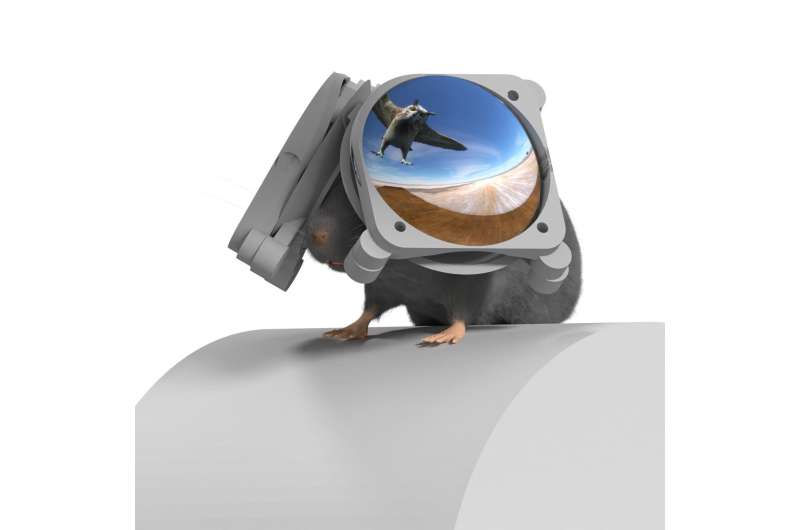January 22, 2024 feature
This article has been reviewed according to Science X's editorial process and policies. Editors have highlighted the following attributes while ensuring the content's credibility:
fact-checked
peer-reviewed publication
trusted source
proofread
Miniature VR goggles for mice could advance neuroscience research

Mice are among the animal species most employed in neuroscience studies, as they are mammals (i.e., their brain is in some ways similar to the human brain) and their genetics or behaviors can be easily manipulated in experimental settings. While training mice to complete specific tasks is straightforward, reliably examining their brain processes when they are outside of laboratory environments is challenging, due to the inability to bring imaging technologies outdoors, the risk that the mice will escape, and/or other complications.
One possible solution to overcome these challenges could be to use virtual reality (VR) or augmented reality (AR) technology to observe how mice behave and how their brain responds when they are virtually exposed to specific scenes or situations. While several research teams have been trying to develop VR goggles or headsets for mice, none of the solutions developed so far cover the animals' entire field of view, which could lead to delayed or different responses from those that the mice would have in real-world settings.
Researchers at Northwestern University recently developed iMRSIV (miniature rodent stereo illumination VR) a new VR goggle system for mice with full field-of-view, Their paper, published in Neuron, suggests that this system could be better suited for conducting neuroscience research, as mice appeared to respond to virtual environments presented through iMRSIV faster than they did when scenes were presented using other previously developed VR systems.
"The most advanced instruments to image brain activity are large, table-top devices that cannot be carried around on a mouse's head as they move through the environment," Daniel Dombeck, lead author of the paper, told Medical Xpress.
"Instead, we hold a mouse's head still under the large microscopes (so we can study their brains) and let them run on a treadmill mounted under their limbs. The movements of the treadmill then move the animal through the virtual world that is displayed in the VR goggles."
The VR-based experimental set-up employed by Dombeck and his colleagues allows them to closely study the brain activity of mice under sophisticated microscopes, all while the animals are virtually navigating virtual environments. These environments may simulate, for instance, complex virtual mazes, outdoor spaces and other scenarios that they expect will elicit specific behavioral responses.
"We are trying to identify the exact neurons in the brain that are forming memories of mazes, and in those neurons, we are trying to identify which synapses are being modified to form the memories and through what mechanisms those synapses are modified," Dombeck explained. "Answering these questions will help us understand how our brains know where we are in the world around us, how we form memories of those experiences, and ultimately, how those memories are degraded in neurodegenerative diseases."
Essentially, the use of virtual environments allows neuroscientists to answer important questions about what happens in the mouse brain in specific scenarios with unprecedented levels of precision (i.e., using the most advanced microscopes available). To carry out these experiments involving mice, Dombeck and his colleagues had so far used VR systems based on large screens, which were developed over a decade ago, yet these systems have significant limitations.
"With big screens, mice can still see the lab frame (table, posts, screen holders, etc) in addition to what we project on the screens," Dombeck said. "This creates a conflict between the moving scene as the mice move through the virtual world and a static scene of the lab frame, which we think reduces their immersion in the virtual world. Also, there is no depth (3D) information provided by big screens, the mice just see the same flat scene as we do when we watch TV."

The miniature VR goggles created by this team of researchers overcome the limitations of existing large-screen VR systems for mice. Firstly, they fully cover the mouse's field of view, thus preventing them from seeing the laboratory environments and other objects within it. In addition, they allow researchers to produce a so-called stereo view, separately controlling what the mice will see in each of their eyes.
"Our goggles design achieves these criteria largely through a unique (custom) lens that we designed and had built specifically for our goggles," Dombeck said. "We also made use of a small flexible OLED screen (like the ones in apple watches) to make a curved display surface, which also turned out to be important for generating a large field of view for each mouse eye."
Dombeck and his colleagues so far used their iMRSIV goggle system in a set of initial experiments, where the mice were presented with simple mazes consisting of long hallways with a reward hidden within them. In a few trials, they also added a 'looming' simulation, with a moving object approaching from the 'sky' above them.
"This stimulation in real environments causes mice to freeze or flee, reactions they have to survive a predatory bird attack in the wild," Dombeck said. "Notably, the mice reacted the same way in our VR goggle system as they typically do in real environments. With this behavior in VR, we could then perform the first studies of how the navigation systems in the brain react to such a looming stimulus (using the advanced brain imaging systems mentioned above)."
Overall, the initial findings gathered by the researchers suggest that their iMRSIV system is far more effective than previously developed VR systems for mice, as it elicits faster behavioral responses in mice. In the 'looming object from the sky' scenario, they also unveiled an interesting pattern in a few of the mice.
"We found some very interesting results in a few mice," Dombeck explained. "Specifically, when these mice were freezing in place after the loom, the navigation neurons were reading out a different location from where the mice actually were. It was as if these mice were thinking about where they would rather be (e.g., a safe covered location up ahead), instead of where they were freezing. We're excited about these results and will follow up more on this since they might help explain how imagination emerges in the brain."
The new VR goggle system created by Dombeck and his colleagues could soon be improved further and used by other neuroscientists. In the future, it could pave the way for interesting new discoveries about what happens in the brain of mice, and potentially other mammals, when they are in different scenarios or while they engage in particular behaviors.
"In our next studies, we also want to make the goggles smaller, so that mice can also carry them around and run through virtual mazes in the real world," Dombeck added.
More information: Domonkos Pinke et al, Full field-of-view virtual reality goggles for mice, Neuron (2023). DOI: 10.1016/j.neuron.2023.11.019.
© 2024 Science X Network





















